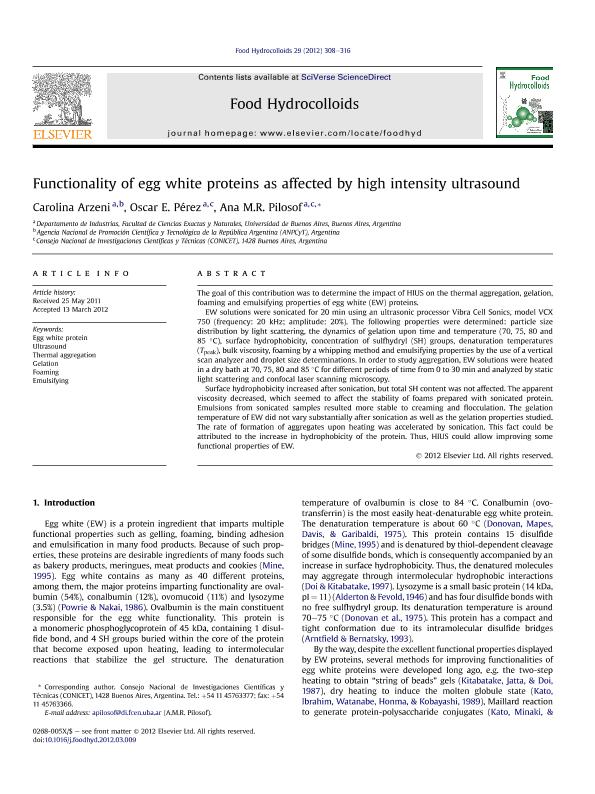Mostrar el registro sencillo del ítem
dc.contributor.author
Arzeni, Carolina

dc.contributor.author
Perez, Oscar Edgardo

dc.contributor.author
Pilosof, Ana Maria Renata

dc.date.available
2023-03-06T10:47:42Z
dc.date.issued
2012-12
dc.identifier.citation
Arzeni, Carolina; Perez, Oscar Edgardo; Pilosof, Ana Maria Renata; Functionality of egg white proteins as affected by high intensity ultrasound; Elsevier; Food Hydrocolloids; 29; 2; 12-2012; 308-316
dc.identifier.issn
0268-005X
dc.identifier.uri
http://hdl.handle.net/11336/189612
dc.description.abstract
The goal of this contribution was to determine the impact of HIUS on the thermal aggregation, gelation, foaming and emulsifying properties of egg white (EW) proteins.EW solutions were sonicated for 20 min using an ultrasonic processor Vibra Cell Sonics, model VCX 750 (frequency: 20 kHz; amplitude: 20%). The following properties were determined: particle size distribution by light scattering, the dynamics of gelation upon time and temperature (70, 75, 80 and 85 °C), surface hydrophobicity, concentration of sulfhydryl (SH) groups, denaturation temperatures (Tpeak), bulk viscosity, foaming by a whipping method and emulsifying properties by the use of a vertical scan analyzer and droplet size determinations. In order to study aggregation, EW solutions were heated in a dry bath at 70, 75, 80 and 85 °C for different periods of time from 0 to 30 min and analyzed by static light scattering and confocal laser scanning microscopy.Surface hydrophobicity increased after sonication, but total SH content was not affected. The apparent viscosity decreased, which seemed to affect the stability of foams prepared with sonicated protein. Emulsions from sonicated samples resulted more stable to creaming and flocculation. The gelation temperature of EW did not vary substantially after sonication as well as the gelation properties studied. The rate of formation of aggregates upon heating was accelerated by sonication. This fact could be attributed to the increase in hydrophobicity of the protein. Thus, HIUS could allow improving some functional properties of EW.
dc.format
application/pdf
dc.language.iso
eng
dc.publisher
Elsevier

dc.rights
info:eu-repo/semantics/openAccess
dc.rights.uri
https://creativecommons.org/licenses/by-nc-sa/2.5/ar/
dc.subject
EGG WHITE PROTEIN
dc.subject
EMULSIFYING
dc.subject
FOAMING
dc.subject
GELATION
dc.subject
THERMAL AGGREGATION
dc.subject
ULTRASOUND
dc.subject.classification
Alimentos y Bebidas

dc.subject.classification
Otras Ingenierías y Tecnologías

dc.subject.classification
INGENIERÍAS Y TECNOLOGÍAS

dc.title
Functionality of egg white proteins as affected by high intensity ultrasound
dc.type
info:eu-repo/semantics/article
dc.type
info:ar-repo/semantics/artículo
dc.type
info:eu-repo/semantics/publishedVersion
dc.date.updated
2023-03-05T15:36:04Z
dc.journal.volume
29
dc.journal.number
2
dc.journal.pagination
308-316
dc.journal.pais
Países Bajos

dc.journal.ciudad
Amsterdam
dc.description.fil
Fil: Arzeni, Carolina. Consejo Nacional de Investigaciones Científicas y Técnicas; Argentina. Universidad de Buenos Aires. Facultad de Ciencias Exactas y Naturales. Departamento de Industrias; Argentina
dc.description.fil
Fil: Perez, Oscar Edgardo. Universidad de Buenos Aires. Facultad de Ciencias Exactas y Naturales. Departamento de Industrias; Argentina. Consejo Nacional de Investigaciones Científicas y Técnicas; Argentina
dc.description.fil
Fil: Pilosof, Ana Maria Renata. Universidad de Buenos Aires. Facultad de Ciencias Exactas y Naturales. Departamento de Industrias; Argentina. Consejo Nacional de Investigaciones Científicas y Técnicas; Argentina
dc.journal.title
Food Hydrocolloids

dc.relation.alternativeid
info:eu-repo/semantics/altIdentifier/url/https://www.sciencedirect.com/science/article/abs/pii/S0268005X12000690
dc.relation.alternativeid
info:eu-repo/semantics/altIdentifier/doi/http://dx.doi.org/10.1016/j.foodhyd.2012.03.009
Archivos asociados
